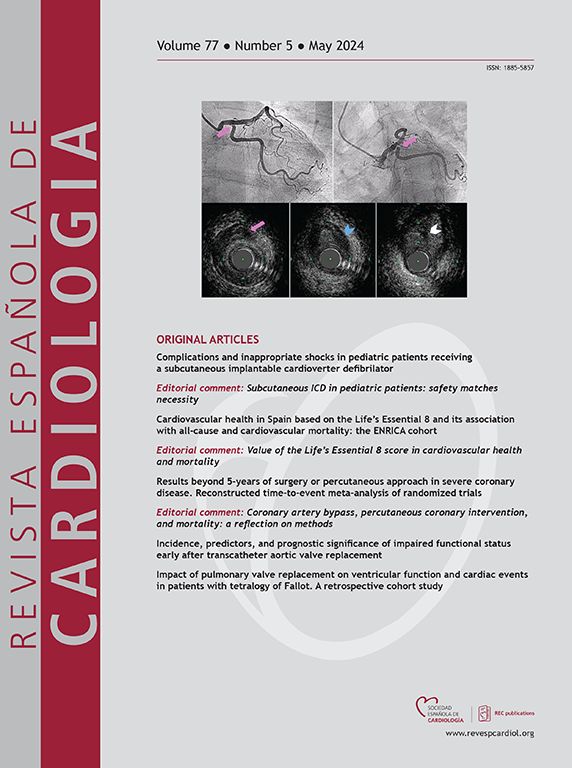Asociación en J entre la apolipoproteína B y resultados CV en pacientes con síndrome coronario crónico tratados con estatinas
IF 5.9
2区 医学
Q2 Medicine
引用次数: 0
Abstract
Introduction and objectives
The association between apolipoprotein B (apoB) and residual cardiovascular (CV) risk in patients with chronic coronary syndrome (CCS) remains unclear. We aimed to investigate the association between apoB levels and CV outcomes in statin-treated CCS patients.
Methods
We enrolled 8641 statin-treated CCS patients at Fuwai Hospital. The patients were divided into 5 groups based on to apoB quintiles (Q1 to Q5). The primary endpoint was 3-year CV events, including CV death, nonfatal myocardial infarction, and nonfatal stroke.
Results
During a median follow-up of 3.17 years, there were 232 (2.7%) CV events. After multivariable adjustment, a restricted cubic spline illustrated a J-shaped relationship between apoB levels and 3-year CV events, with the risk remaining flat until apoB levels exceeded 0.73 g/L, after which the risk increased (nonlinear P < .05). Kaplan-Meier curves showed the lowest CV event rate in the Q3 group (0.68-0.78 g/L). Compared with the Q3 group, multivariable Cox regression models revealed that both low (Q1, ≤ 0.57 g/L) and high (Q5, > 0.93 g/L) apoB levels were associated with an increased risk of major adverse cardiac events (all P < .05). Notably, patients with low apoB levels (Q1) had the highest risk of CV death (HR, 2.44; 95%CI, 1.17-5.08).
Conclusions
Our analysis indicates that both low and high levels of apoB are associated with elevated CV risk, with the risk being particularly pronounced at higher levels (> 0.73 g/L).
在接受他汀类药物治疗的慢性冠状动脉综合征患者中,载脂蛋白B与CV结果之间的J相关性
慢性冠状动脉综合征(CCS)患者载脂蛋白B (apoB)与剩余心血管(CV)风险之间的关系尚不清楚。我们的目的是研究他汀类药物治疗的CCS患者载脂蛋白ob水平与CV结果之间的关系。方法选取阜外医院接受他汀治疗的CCS患者8641例。根据载脂蛋白五分位数(Q1 ~ Q5)将患者分为5组。主要终点是3年CV事件,包括CV死亡、非致死性心肌梗死和非致死性卒中。结果在3.17年的中位随访期间,共发生232例(2.7%)CV事件。多变量调整后,限制性三次样条曲线显示载脂蛋白ob水平与3年CV事件之间呈j型关系,在载脂蛋白ob水平超过0.73 g/L之前,风险保持平稳,之后风险增加(非线性P <;. 05)。Kaplan-Meier曲线显示,Q3组CV事件发生率最低(0.68-0.78 g/L)。与Q3组相比,多变量Cox回归模型显示,低(Q1,≤0.57 g/L)和高(Q5, >;0.93 g/L)载脂蛋白ob水平与主要心脏不良事件的风险增加相关(P <;. 05)。值得注意的是,低载脂蛋白ob水平(Q1)的患者CV死亡风险最高(HR, 2.44;95%可信区间,1.17 - -5.08)。结论sour分析表明,低水平和高水平载脂蛋白ob均与心血管风险升高相关,高水平载脂蛋白ob的风险尤为明显(>;0.73 g / L)。
本文章由计算机程序翻译,如有差异,请以英文原文为准。
求助全文
约1分钟内获得全文
求助全文
来源期刊

Revista espanola de cardiologia
医学-心血管系统
CiteScore
4.20
自引率
13.60%
发文量
257
审稿时长
28 days
期刊介绍:
Revista Española de Cardiología, Revista bilingüe científica internacional, dedicada a las enfermedades cardiovasculares, es la publicación oficial de la Sociedad Española de Cardiología.
 求助内容:
求助内容: 应助结果提醒方式:
应助结果提醒方式:


